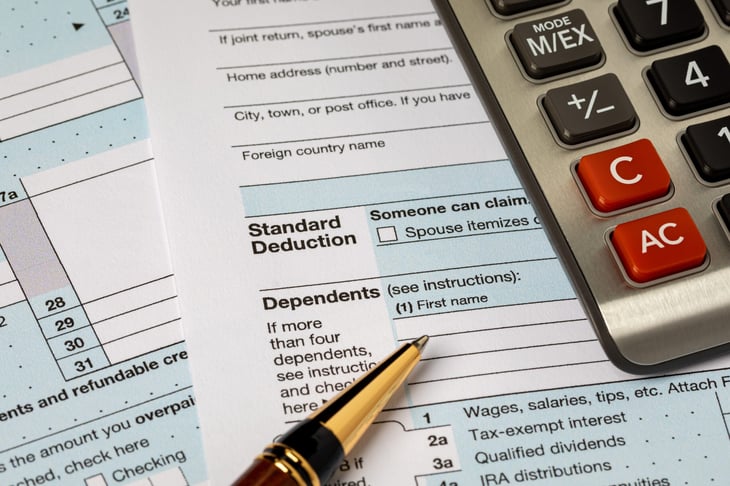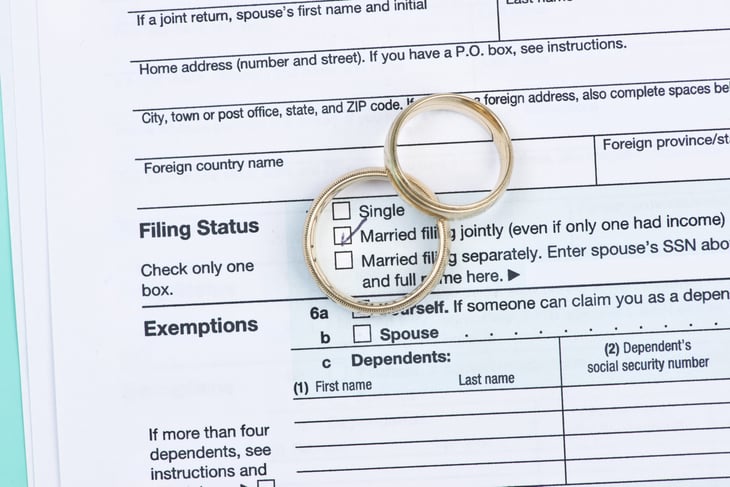
The federal government regularly adjusts everything from Social Security benefits to retirement account limits to account for inflation.
The same goes for some key aspects of federal income taxes, including the standard deduction and income brackets, which determine your tax rate. And 2024 is no exception: Every standard deduction and income bracket is increasing — and by more than usual, due to lingering inflation.
Following is a look at how the standard deduction and income brackets have changed for the 2024 tax year — the one for which your tax return is due by April 2025.
Standard deductions for 2024

No one is taxed on every dollar they earn. So, not all the income you earn in 2024 will be taxed at the applicable tax rate (which we’ll get to next).
One reason for this is tax deductions, which reduce your taxable income. Most taxpayers — around 88% — opt to take the standard deduction, which is a flat amount, as opposed to itemizing their tax deductions.
The exact amount of your standard deduction depends on your tax-filing status, age and sometimes other factors. Read on to learn exactly what yours will be for 2024.
Taxpayers under age 65

The standard deduction gets adjusted regularly for inflation. For 2024, the deduction is worth:
- $29,200 if your tax-filing status is married filing jointly or surviving spouse (up $1,500 from $27,700 for 2023)
- $21,900 if your tax-filing status is head of household (up $1,100 from $20,800)
- $14,600 if your tax-filing status is single or married filing separately (up $750 from $13,850)
This means that a married couple filing a joint tax return, for example, would not owe any taxes on the first $29,200 of their 2024 income if they choose to take the standard deduction — assuming both individuals are younger than 65.
Older and blind taxpayers

Taxpayers who are 65 or older, as well as those who are blind, generally qualify for an extra boost to their standard deductions. For 2024, such taxpayers generally get an additional $1,550 per married person (up from $1,500) or $1,950 per single person (up from $1,850).
So, if two married seniors file a joint return, for example, their standard deduction would be $32,300 ($29,200 + $1,550 + $1,550).
Just note that the IRS has its own definitions of “65” and “blindness.”
For 2024, a taxpayer must be born before Jan. 2, 1960, to be eligible for a higher standard deduction based on age.
To learn more about the higher standard deduction for blindness, see IRS Publication 501.
Tax brackets and rates for 2024

An income bracket is simply a range of dollar amounts — specifically, a range of taxable income, meaning your income after tax deductions and credits. This is important because the bracket into which your specific taxable income falls determines your tax rate — the percentage of your taxable income that you owe to Uncle Sam.
Following are the 2024 income brackets and tax rates for each tax-filing status — married filing jointly, qualifying surviving spouse, head of household, single, and married filing jointly.
To determine your tax rate, find your filing status and select the most applicable corresponding income bracket. To the right of that bracket is your rate.
Married filing jointly

For married couples who file a joint tax return, the 2024 income brackets and corresponding tax rates are as follows:
- Up to $23,200 (was $22,000 for 2023) — 10%
- More than $23,200 (was $22,000) — 12%
- More than $94,300 (was $89,450) — 22%
- More than $201,050 (was $190,750) — 24%
- More than $383,900 (was $364,200) — 32%
- More than $487,450 (was $462,500) — 35%
- More than $731,200 (was $693,750) — 37%
Let’s say, for example, your tax-filing status is married filing jointly and you and your spouse have a taxable income of $50,000 for 2024. You would fall into the “more than $23,200” bracket and your tax rate would thus be 22%.
Qualifying surviving spouse

The income brackets and tax rates for the tax-filing status of qualifying surviving spouse, which was previously known as qualifying widow(er), are the same as those for married filing jointly.
This status is reserved for people whose spouse died during the two tax years before the year for which a survivor is filing a return. So, a widow or widower who lost their spouse in 2022 or 2023 could use this filing status on their 2024 tax return if it would be more financially advantageous to them than using the status of single.
Head of household

For individuals who meet the IRS’ definition of a “head of household” — which you can find out by using the agency’s free filing-status tool — the 2024 income brackets and corresponding tax rates are as follows:
- Up to $16,550 (was $15,700 for 2023) — 10%
- More than $16,550 (was $15,700) — 12%
- More than $63,100 (was $59,850) — 22%
- More than $100,500 (was $95,350) — 24%
- More than $191,950 (was $182,100) — 32%
- More than $243,700 (was $231,250) — 35%
- More than $609,350 (was $578,100) — 37%
Example: Your tax-filing status is head of household and your taxable income is $50,000 for 2024. You would fall into the “more than $16,550” bracket and your tax rate would thus be 12%.
Single

For the tax-filing status of single, the 2024 income brackets and corresponding tax rates are:
- Up to $11,600 (was $11,000 for 2023) — 10%
- More than $11,600 (was $11,000) — 12%
- More than $47,150 (was $44,725) — 22%
- More than $100,525 (was $95,375) — 24%
- More than $191,950 (was $182,100) — 32%
- More than $243,725 (was $231,250) — 35%
- More than $609,350 (was $578,125) — 37%
Example: Your filing status is single and your taxable income is $50,000 for 2024. You would fall into the “more than $47,150” bracket and your tax rate would thus be 22%.
Married filing separately

For married individuals who file a separate tax return from their spouse, the 2024 income brackets and corresponding tax rates are:
- Up to $11,600 (was $11,000 for 2023) — 10%
- More than $11,600 (was $11,000) — 12%
- More than $47,150 (was $44,725) — 22%
- More than $100,525 (was $95,375) — 24%
- More than $191,950 (was $182,100) — 32%
- More than $243,725 (was $231,250) — 35%
- More than $365,600 (was $346,875) — 37%
Example: Your tax-filing status is married filing separately and your taxable income is $50,000 for 2024. You would fall into the “more than $47,150” bracket and your tax rate would thus be 22%.





Add a Comment
Our Policy: We welcome relevant and respectful comments in order to foster healthy and informative discussions. All other comments may be removed. Comments with links are automatically held for moderation.